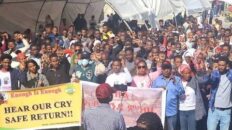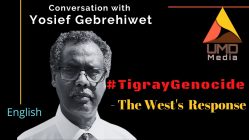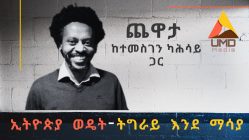TPLF’s Internal Power Struggles: A Crisis of “Democratic Centralism”
Major General Teklebrhan W/Aregay (PhD)*
July 20, 2024
The Tigray People’s Liberation Front (TPLF) has a long history of internal dissent, often culminating in power struggles resolved through a warped interpretation of “democratic centralism.” This article examines this pattern and explores ways to break the cycle of suppression and societal division.
Democratic Centralism: A Weapon of Control?
Democratic centralism, a Leninist concept, allows for open debate within a party followed by unified action based on the majority decision. In theory, it fosters a healthy exchange of ideas. However, the TPLF leadership has weaponized this concept. Vigorous debate is stifled, and dissenters are labeled as factionalists (ኣንጃ/ዝተሸኽሉ/ፅግዕተኛ ምብስባስ) and targeted through tactics like forced participation in large, grueling meetings (“crowded techniques”) to intimidate them into submission.
A Cycle of Crisis and Suppression
The TPLF has faced numerous internal political crises throughout its history. Each crisis, like “Hinfishfish”/Spoilers (1976), “Stagnation” (1985), “Bonaparte” (2000), and the recent “Parasitic Decay” (2024), followed a similar pattern:
- Dissent Emerges: Party members raise concerns about internal factions, lack of vision, self-serving leadership, or decay at the top.
- Suppression Through “Democratic Centralism”: Open debate is shut down. Leaders like Aregawi Berhe, Gidey Zeratsion (1985), Tewolde Woldemariam, Aregash Adane (2000), and potentially Getachew Reda, Beyene Mekru (2024), are scapegoated through drawn-out “Tehadso” (renewal) seminars.
- Win-Lose Mentality: The dominant faction emerges victorious, while dissenters are ostracized. This “win-lose” mentality breeds resentment and fuels the cycle for the next crisis.
Beyond the Party Walls: Societal Fragmentation
The TPLF’s internal conflicts have a ripple effect on Tigrayan society. The party’s culture of suppression “leaks” outwards, creating societal divisions. For instance, the 1985 crisis is believed to have weakened Tigrayan nationalism and fostered Ethiopianism. Similarly, the 2000 crisis mirrored in the fragmentation of the Tigray Development Association. The current crisis might lead to further national fragmentation.
Breaking the Cycle: Pathways to a United Tigray
The solution lies not just within the TPLF, but in a broader societal shift:
- Rethinking Ideology: Recognizing the TPLF’s distorted Marxist-Leninist ideology as a root cause is crucial.
- Benign Nationalism: Elevating benevolent Tigrayan nationalist forces who prioritize unity and progress over internal power struggles can heal societal divisions.
- Internal Reform or External Pressure? Whether the TPLF reforms itself or faces external pressure for change remains to be seen. However, internal dissenters pushing for reform offer a glimmer of hope.
A Call to Action for Tigrayans
The TPLF’s internal struggles have had a devastating impact on Tigray. It is imperative to minimize the party’s role in the nation’s future. By acknowledging the root causes of these struggles and empowering positive forces that prioritize Tigray’s advancement and unity, we can break free from this destructive cycle. This requires a collective effort from patriotic Tigrayans across all sectors of society. Only then can Tigray move beyond the limitations of the past and build a stronger, more unified future.
*Major General Teklebrhan W/Aregay was a member of the TPLF during its armed struggle years and is the founder of Ethiopia’s Information Network Security Agency (INSA) and served as its first Director General.
Editor’s Note: The opinions expressed in the articles published on UMD Media are solely those of the individual authors and do not necessarily reflect the views or opinions of the editorial team or UMD Media as an organization. The publication of any opinion piece does not imply endorsement or agreement by UMD Media. Readers are encouraged to critically evaluate the content and form their own conclusions. Leave your comments below. Send us your thoughts and reflections to umd.media.2020 at gmail dot com.
Guidelines for contributors All contributions and comments submitted to UMD Media must adhere to the following guidelines. Respectful Language: Avoid using ethnic adjectives that generalize or portray an entire ethnic group in a negative light. Such language is harmful, divisive, and contrary to our commitment to fostering a respectful and inclusive environment. No Incitement: Content that incites hatred, violence, or discrimination against any individual or group based on ethnicity, race, religion, etc will not be tolerated. Constructive Dialogue: We encourage constructive dialogue and the sharing of diverse perspectives. However, it is essential to express opinions in a manner that respects the dignity and humanity of all individuals and groups. Moderation and Enforcement: Our editorial team reserves the right to moderate and, if necessary, remove any content that violates these guidelines. Repeat offenders may be subject to account suspension or banning. By contributing to our platform, you agree to abide by these guidelines and help us maintain a respectful and inclusive community.
Subscribe to UMD Media channel. Join UMD Media Telegram Channel: https://t.me/UMDMedia




